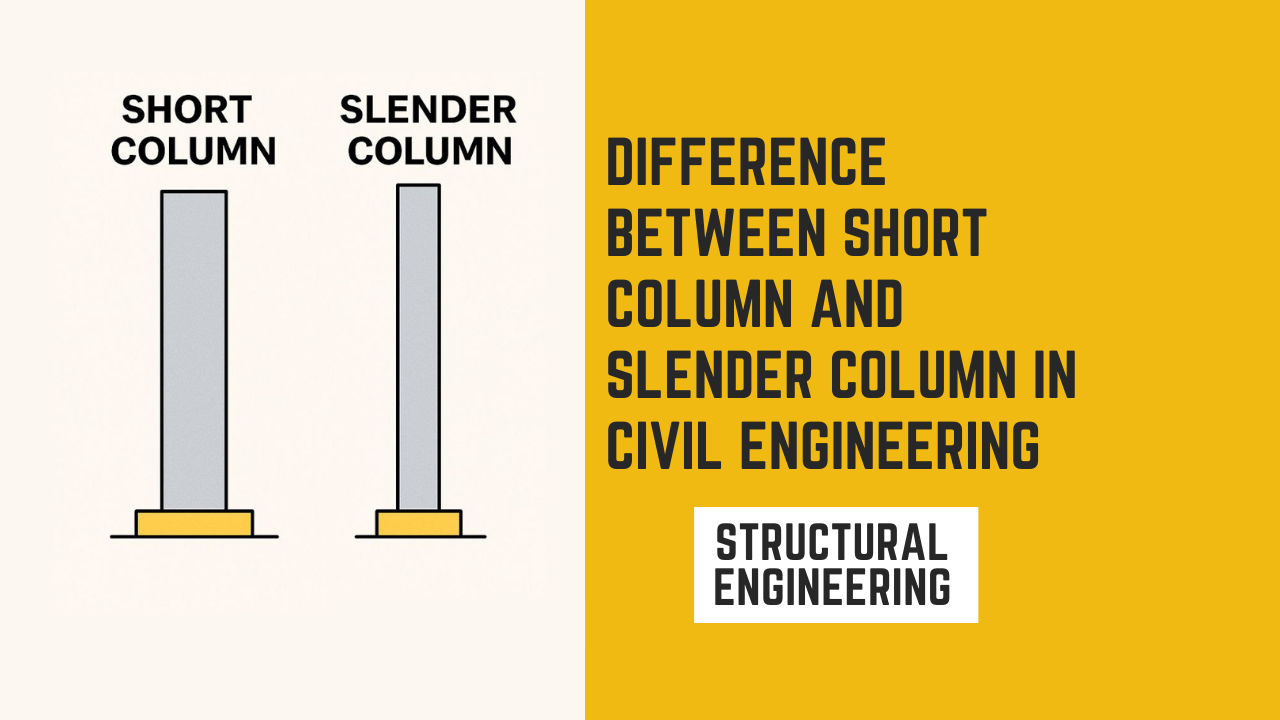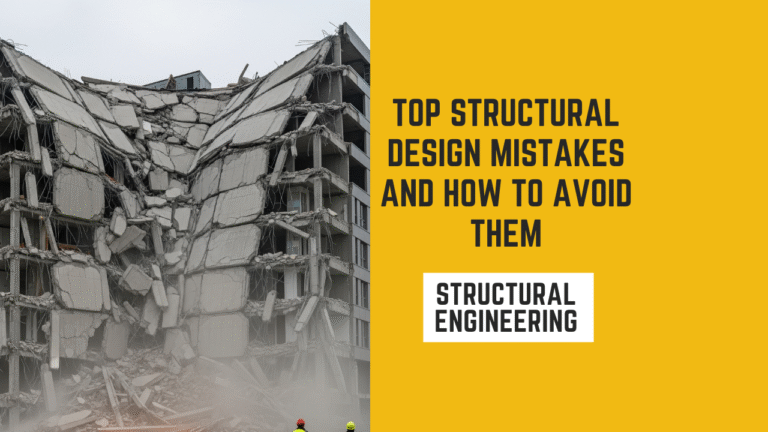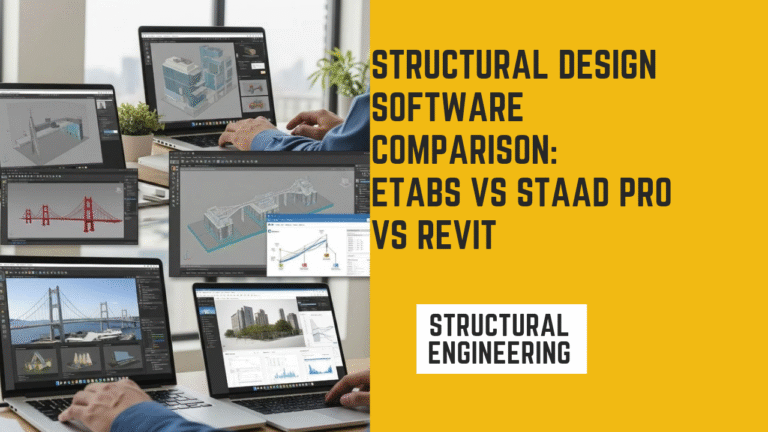Difference between short column and slender column in Civil Engineering

Introduction
Columns are crucial structural elements that transfer loads from slabs, beams, and upper floors to the foundation of a building. Their design, classification, and behavior under loads determine the overall safety and stability of any structure. Among the various ways to classify columns, one of the most important is based on slenderness ratio—this divides columns into short columns and slender (long) columns.
Understanding The difference between short and slender columns is vital for civil engineers, architects, and construction professionals. this article provides a comprehensive analysis of both types, including definitions, behavior, design considerations, advantages, disadvantages and real-world applications
1. Definition of Columns
Before diving into differences, it’s essential to understand what a column is.
A column is a vertical structural member designed primarily to support axial compression. Columns are used to carry the load of the superstructure and transmit it to the foundation
2. What Is Slenderness Ratio?
The slenderness ratio is a key factor in determining whether a column is short or slender. It is given by
> Slenderness Ratio (λ) = Effective Length (Le) / Least Radius of Gyration (r)
Where:
Effective Length (Le) = The length of the column between points of zero moment (depends on end conditions).
Radius of Gyration (r) = √(I/A), where I = Moment of inertia, A = Area of the cross-section.
Based on the slenderness ratio:
- If λ < 12 → Short Column
- If λ > 12 → Slender Column
(Note: Some codes, like ACI and IS 456, may use slightly different limits.)
3. What is a short column?
A short columns is one whose slenderness ratio is low (typically less than 12). these columns are strong and fail primarily due to material crushing, not buckling
Characteristics of Short Columns
- Low slenderness ratio (λ < 12)
- Fail due to axial compressive stresses
- Crushing is the dominant mode of failure
- More capacity to resist axial loads
- Less lateral deformation
- Found in low-rise buildings or heavily braced structures
4. What Is a Slender Column?
A slender columns, also known as a long column, has a higher slenderness ratio (greater than 12)
It is more susceptible to buckling, a form of instability, even if the axial load is below the material’s crushing strength.
Characteristics of Slender columns
- High slenderness ratio(λ > 12))
- Prone to buckling failure
- Load-carrying capacity is significantly affected by length
- More lateral deflection
- Require more complex capacity is significantly affected by length
- Common in tall, slender buildings or unbraced frames
5. Key Differences Between Short and Slender Columns
| Feature | Short Column | Slender Column |
| Slenderness Ratio | λ < 12 | λ > 12 |
| Failure Mode | Crushing | Buckling |
| Load Capacity | Higher | Lower |
| Lateral Deflection | Minimal | Significant |
| Behavior | Axial compressive failure | Instability failure |
| Design Simplicity | Easier | Complex |
| Application | Low-rise, braced buildings | High-rise, unbraced structures |
| Code Requirements | Less stringent for stability | Requires buckling analysis |
6. Failure Behavior Explained
Short Columns Failure:
Short columns primarily fail by crushing of the concrete or yielding of steel reinforcement. Since their length is small, the column remains straight under load and directly compresses.
- Safe for high loads
- Typically exhibits ductile behavior
- Warning signs before collapse (cracking, spalling)
Slender Columns Failure:
Slender columns experience buckling, where the column bends sideways and loses capacity rapidly, even at loads lower than its theoretical crushing strength.
- Sudden and brittle failure
- Requires accurate geometric and load modeling
- No warning signs before failure
7. Design Considerations
For Short Columns:
- Designed mainly for axial loads
- Slenderness is not critical
- Simpler moment and axial load interaction diagrams
- Reinforcement mostly for axial capacity and minor moments
For Slender Columns:
- Must consider P-Δ effects (second-order effects)
- Requires moment magnification factors due to slenderness
- Use of Euler’s buckling equation or code-based slenderness reduction factors
- Reinforcement and section must resist both axial load and lateral deflection
8. Practical Applications
Where Short Columns Are Used
- Residential building’s
- Warehouse with low roof heights
- Braced frames or buildings with shear walls
- Bridges with short piers
Where Slender Columns Are Used:
- Skyscrapers and high-rise towers
- Open frame structures without lateral bracing
- Communication towers
- Industrial buildings with long spans

9. How to avoid column failure
For Short Columns:
- Ensure proper mix design and curing
- Use adequate cross-section and reinforcement
- Avoid adequate cross-section and reinforcement
For Slender Columns:
- Reduce effective length via bracing or fixing ends
- Increase cross-section or provide intermediate lateral supports
- Consider lateral loads (wind, earthquake)
- Perform buckling analysis and use appropriate slenderness reduction factors
- Reduce effective length via bracing or fixing ends
10. Code Provisions and Standards
Most structural design codes address both types of columns with specific guidelines:
IS 456:2000 (Indian Standard):
Defines short and long columns based on slenderness ratio
Specifies design provisions for buckling
ACI 318 (American Concrete Institute):
Requires second-order analysis for slender columns
Provides moment magnification methods
Eurocode 2 (EN 1992-1-1):
Defines slenderness and introduces buckling reduction methods
Uses column curves and nonlinear analysis
11. Common Mistakes in Column Design
- Ignoring buckling in slender columns
- Assuming all columns are short
- Improper end condition assumptions
- Inadequate lateral bracing
- Neglecting second-order effects
Such mistakes can lead to catastrophic structural failures, especially in high-rise buildings
12. Case Studies: Column Behavior in Real Structures
A. Short Column Effect in Earthquakes (Turkey, 2023)
Short columns led to sudden collapse of buildings due to constrained ends that caused shear failure. this is known as the short column effect, where partial height infill walls cause concentration of stress
Short columns led to sudden collapse of buildings due to constrained ends that caused shear failure. This is known as the short column effect, where partial height infill walls cause concentration of stress.
B. Slender Column Buckling (Hyatt Regency Walkway Collapse, 1981):
Although not purely a column buckling issue, poor understanding of load paths and slender structural members contributed to the failure.
These examples highlight the importance of considering both crushing and buckling failure mechanisms.
13. Importance of End Conditions in Column Classification
End conditions play a crucial role in determining the effective length of a column, which directly influences its slenderness ratio. The same physical column can behave like a short or slender column depending on how its ends are supported
Common End Conditions:
- Pinned-Pinned: Both ends are free to rotate, and no moment is transferred.
- Fixed-Fixed: Both ends are restrained, reducing the effective length significantly.
- Fixed-Free (Cantilever): One end is fixed, and the other is free—most critical for buckling.
- Fixed-Pinned: One end is restrained, and the other is pinned.
- Each condition corresponds to an effective length factor (K) used in the calculation:
> Le = K × L, where L = actual length of the column.
For example:
Fixed-Fixed: K = 0.5
Pinned-Pinned: K = 1.0
Fixed-Free: K = 2.0
Understanding and correctly assigning end conditions is vital to avoid underestimating slenderness and potential buckling.
14. Use of Software in Column Design
Modern civil engineers use structural analysis and design software like ETABS, SAP2000, STAAD.Pro, and ProtaStructure to model column behavior. These tools:
- Automatically calculate slenderness ratios
- Perform second-order (P-Δ) analysis
- Apply code-based design checks
- Visualize buckling modes
Software modeling helps minimize manual errors, especially in complex, multi-story buildings where hundreds of columns exist.
14. Conclusion
Understanding The difference between short and slender columns is critical in the field of civil engineering. Short columns are strong and stable but need to be properly reinforced and constructed. Slender columns, while often used in tall and elegant structures, demand rigorous analysis to prevent sudden buckling failure
Key Takeaways:
- Use the slenderness ratio to classify columns.
- Short Column fail due crushing, while slender columns fail due to buckling
- Slender columns require advanced analysis and are sensitive to initial imperfections.
- Safe design must follow code provisions and consider realistic load conditions.
- Use the slenderness ratio to classify columns.






